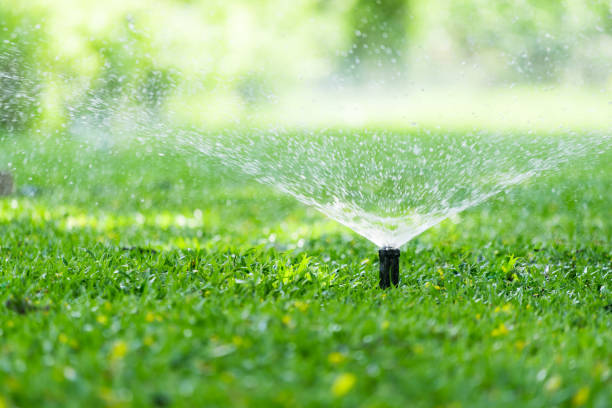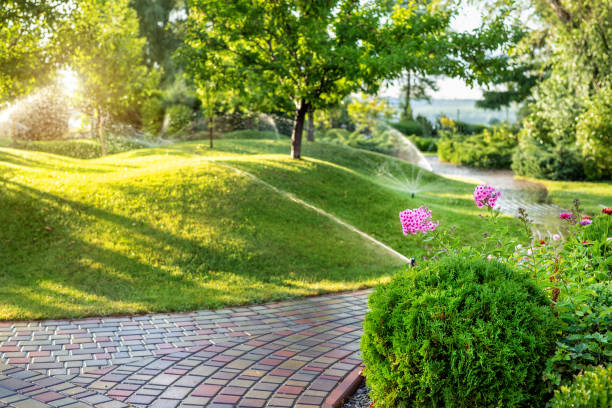What are the 3 Types of Irrigation?
Surface irrigation is one of the most common methods used worldwide. The types include furrow, basin, border and wild flooding. Its advantages are its simplicity and low cost in terms of equipment and operation.
Exploring Different Types of Irrigation Systems
Drip irrigation delivers water directly to the root zone of plants using low-pressure pipes fitted with outlets called emitters or drippers. It’s ideal for areas with limited water resources.
Exploring Different Types of Irrigation System
In sprinkler systems, water is distributed overhead in a manner resembling natural rainfall. The system comprises pumps, tubing, and sprinkler heads that can be fixed or rotating. Key benefits are uniform distribution of water even on irregular fields, and flexibility in use – it can be used for almost any field crops.
Exploring Different Types of Irrigation Systems for Agriculture
It’s an effective solution for sandy soils where surface watering may result in high evaporation rates.
Exploring Different Irrigation Methods
This method is more suitable for larger fields.
Exploring the 3 Types of Irrigation
Manual irrigation implies that man power is predominantly used for supplying the field with water through pitchers or buckets.
Each system has its own unique advantages and disadvantages which highlight their suitability under varying conditions including crop type, topography, soil type, water quality, and availability. Additionally, economic considerations such as the cost of installation and operation can also dictate the choice of irrigation system.
Proper understanding and selection of an irrigation system according to the specific requirements and resources can significantly contribute to enhanced water use efficiency, crop yield, and sustainable agricultural practices. It’s important for farmers to analyze their specific needs before choosing an irrigation method in order to make the most out of their resources while ensuring a healthy crop yield.
Comprehensive Guide to Agricultural Irrigation Systems
Well and tube well irrigation techniques are two of the primary irrigation methods employed in several parts of the world. They are especially prevalent in regions where water levels are significantly below the surface, making other forms of irrigation less viable. For instance, hilly terrains or arid regions.
Well Irrigation
Well irrigation involves extracting groundwater from wells and using it to irrigate nearby fields. This technique is quite popular in regions with a high water table or in areas where canal irrigation isn’t feasible due to topographical limitations.
- Localized Water Source:The well serves as a localized source of water, reducing reliance on distant water bodies.
- Highly Efficient:Since the water is sourced locally, there is minimal loss due to seepage or evaporation.
- Controlled Water Use:Farmers can control the amount of water used for irrigation, which helps avoid overwatering.
- Seasonal Variability:The water availability in wells may vary seasonally depending on rainfall patterns.
Tube Well Irrigation
Tube well irrigation refers to the extraction of groundwater through tube wells for watering fields. A tube well comprises a long pipe drilled into an aquifer with a motorized pump pulling up the water.
- Significant Water Discharge:Tube wells can discharge substantial volumes of water, facilitating better crop growth.
- Operational Flexibility:They offer operational flexibility as farmers can control the timing and quantity of irrigation.
- High Installation Cost:The cost associated with installing tube wells can be prohibitive for small-scale farmers.
- Dependence on Electricity:The operation of tube wells largely depends on the availability of electricity, which can be inconsistent in certain areas.
| Well Irrigation | Tube Well Irrigation | |
| Advantages | Localized water source, High efficiency, Controlled water use | Significant water discharge, Operational flexibility |
| Disadvantages | Limited capacity, Seasonal variability | High installation cost, Dependence on electricity |
Their selection primarily depends on various factors like geographical location, availability of resources, and farmers’ financial capabilities. Although these techniques offer numerous benefits like water control and local sourcing, they also come with challenges such as dependency on electricity or varying water availability. Proper planning can help overcome these obstacles and maximize the effectiveness of these irrigation techniques.
Comprehensive Guide to Different Types of Irrigation
Channel irrigation is a commonly implemented method of water distribution for agricultural purposes. This method has been in use for centuries, and it involves the creation of an extensive network of canals that carry water from rivers to fields.
- Feeder canals: They carry water directly from the river without any cultivation being carried along their course.
- Carrier canals: These not only carry water but also lead it to the agricultural fields.
- Field or Distributary canals: They draw water from the main or branch canal and distribute it over the area of agricultural land.
How Canal Irrigation Works
Canal irrigation operates on a relatively simple principle: using gravity to transport water. The source river’s flow must be elevated relative to the fields that need irrigating. Once this is established, a network of smaller channels are created that stem from the primary channel, creating a grid-like pattern across the farming area, ensuring uniform distribution.
The construction process involves removing soil along a predetermined path and using it to create banks on either side of the canal. The base and sides are often lined with concrete or another impermeable material to prevent seepage loss.
Advantages of Canal Irrigation
- Cost-effective: once established, canal irrigation systems require little maintenance cost.
- Sustainability: it uses naturally flowing sources like rivers making it sustainable.
- Soil preservation: regular flooding prevents salt accumulation in soil.
Challenges with Canal Irrigation
- Dependence on topography: The success heavily depends on terrain as gravity is needed for water flow.
- Overuse may lead to waterlogging: excess use may lead to an increased groundwater table causing roots suffocation due to lack of air.
- Disease spread: stagnant water can serve as a breeding ground for mosquitoes and other disease vectors.
Canal Irrigation Management
Proper management of canal irrigation is essential to maximize its benefits and minimize issues.
- Use of modern technology: implementing automated systems to control the flow and manage water levels.
- Regular Maintenance: regular cleaning and repair of the canals prevent sediment buildup and breaches.
- Education: farmers should be educated on correct irrigation practices to prevent overuse or misuse.
Overall, canal irrigation stands as an effective and sustainable method for water distribution in agriculture. With correct implementation and management practices, it can significantly enhance crop production.
Exploring Different Types of Irrigation Systems
Tank irrigation is a traditional form of irrigation that has been used for centuries in many parts of the world. Despite its long history, this method continues to be relevant today due to the numerous benefits it offers. However, like any other system, tank irrigation also comes with certain challenges.
Benefits of Tank Irrigation
- Water Conservation: Tank irrigation helps conserve water by capturing and storing runoff water from rainfall or streams. This stored water can then be used for irrigation during dry periods, reducing the reliance on groundwater or other sources.
- Soil Conservation: By slowing down and storing run-off, tank irrigation also helps to control soil erosion. The tanks act as sedimentation basins where sediment-laden runoff can deposit its load before flowing out.
- Fertility Enhancement: The deposited sediments often contain valuable soil nutrients that enhance the fertility of the agricultural fields downstream.
- Cost-effective: Tank construction usually involves local materials and labor, which makes it cost-effective compared with other more technologically advanced forms of irrigation such as drip or sprinkler systems.
- Decentralisation: Unlike canal or well-based systems that require a centralized distribution system, each farmer can own and manage their own tank, giving them more control over their water resources.
Challenges in Tank Irrigation
- Maintenance Issues: Tanks require regular maintenance including de-silting and repair of bunds or sluices which may be costly.
- Water Availability: Water availability is highly dependent on rainfall patterns which could be erratic due to climate change effects.
- Land Submergence: Large areas of fertile agricultural land may get submerged under water when tanks are created or expanded.
- Evaporation Losses: In hot climates evaporation losses from open tanks can be substantial.
- Water Quality: In absence of proper management, water in tanks can become polluted due to runoff from agricultural fields or human and animal activities.
Consideration of these challenges is important when planning for tank irrigation as addressing them early in the design process can significantly improve the system’s sustainability and effectiveness.
The benefits and challenges of tank irrigation underscore the importance of incorporating traditional knowledge into modern agricultural practices.
A Deep Dive into Various Other Types of Irrigation Techniques
While we have covered well, tube well, canal and tank irrigation techniques in previous sections, there are also several other methods used across different parts of the world. Let’s take a deep dive into these various other types of irrigation techniques.
Drip Irrigation
- Advantages
- Efficient use of water
- Reduced weed growth
- Higher crop yield
- Disadvantages
- High installation cost
- Regular maintenance needed
- Not suitable for all crop types
Sprinkler Irrigation
This method resembles natural rainfall as it sprays water into the air over crops using sprinklers, which then breaks up into small water drops falling to the ground.
- Advantages
- Even distribution of water
- Suitable for all types of soil
- Can be used on uneven land
- Disadvantages
- High operation cost
- Water loss due to evaporation
- Not suitable for windy areas
Subsurface Irrigation
This can be done through a network of pipes with holes that allow water to seep out.
- Advantages
- Reduced evaporation loss
- No interference with surface activities.
- Low maintenance costs
- Disadvantages
- Initial high installation costs
- Potential for root intrusion into pipes
Furrow Irrigation
Furrow irrigation involves digging furrows between crop rows and filling them with water.
- Advantages
- Low installation cost
- Suitable for crops with wide row spacing
- Can be managed with unskilled labour
- Disadvantages
- Uneven water distribution
- Possible soil erosion
These are just a few examples from the vast field of irrigation techniques. By understanding these different techniques, farmers can make informed decisions that would potentially increase their crop yield while ensuring efficient use of resources.
- Exploring Different Types of Irrigation Systems for Agriculture
- Exploring Different Types of Irrigation and Their Applications
- Understanding Different Types of Irrigation System
- Exploring Different Types of Irrigation: A Comprehensive Guide
- Discovering the Different Types of Irrigation

